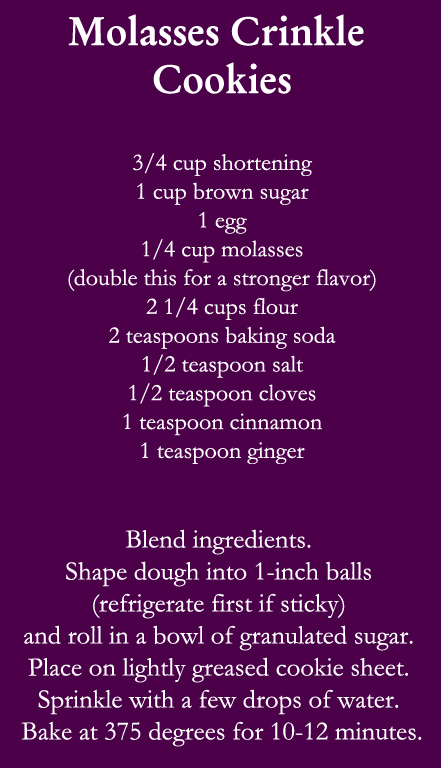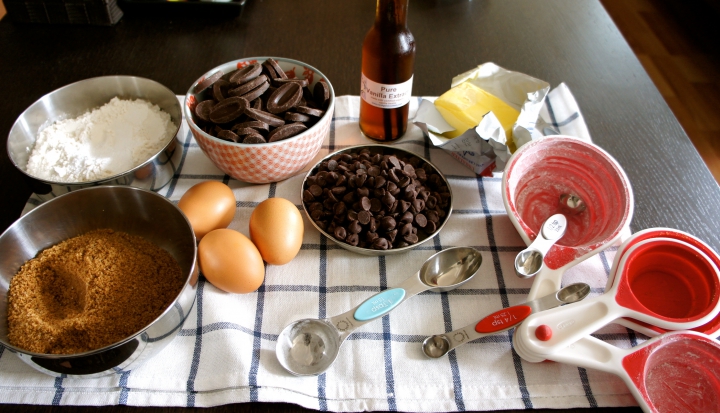Growing up, I spent one week every summer with my grandparents in upstate New York. It was a week full of traditions and rituals that were repeated year after year, immersing me not only in the love my grandparents and I shared, but also our family history. We went for walks in the woods, visited the tiny public library, and I played with giant pickle jars full of buttons. Most important, we baked molasses cookies.
Like the rest of the week, baking also had a rhythm. My grandmother would take down her old flour sifter from the top shelf, and I would get to work it, watching the flour, baking soda, and other dry ingredients mix together and settle into a pillowy heap in the bowl. I remember using a tablespoon to measure out balls of dough, rolling each one in sugar and flattening it with a glass. Everything about the experience has stuck with me— wearing an apron that was much too big, the feel of the old tin measuring cups, how we greased the cookie sheets with an old butter wrapper, and how it felt to kneel on the tall antique stool so that I was tall enough to reach the counter. And, of course, the taste of the cookies warm out of the oven.
Baking is a finicky science. Flour is scooped into a measuring cup and then leveled. Brown sugar is packed tightly into a measuring cup or spoon before being dumped into a mixing bowl. The addition of medium versus extra-large eggs results in a completely different texture for cookies or cake. And, if you overbeat those eggs, a cake will lose the air bubbles that make it light, and it will sink in the middle. You’d think you were in the home stretch once the dessert is in the oven, but there are only a couple of minutes of baking time between golden-brown chewy cookies and blackened lumps. Every time I move to a new apartment, it takes me a couple trys to figure out my new oven’s temperament and quirks.
Not all our time was spent having outdoor adventures and bonding in the kitchen. It was during those summer weeks that my grandma also showed me how to pray, teaching me the Lord’s Prayer and helping me memorize psalms.
Back then, both baking and prayer had an element of the fantastical. Butter, flour, molasses, and eggs—none of which are particularly tasty on their own—came together to make the most delicious cookies in the world. When not memorizing “The Lord is my shepherd,” my prayers at the time went something along the lines of, “Dear Jesus, thank you for Mommy and Daddy and my teddy bear. Help it to not rain tomorrow so I can play outside. Amen.” In my mind, this somehow made me closer to God and more likely to go to heaven when I died. (To be honest, my childhood self may have had a limited understanding of the exact purpose of prayer.)
But as I grew older I realized that baking is not only a science, but an art. An art where the product can be more than the sum of the individual ingredients and where, if you know what you’re doing, innovation can lead to all kinds of discoveries. Vegetable oil can be substituted with shortening, butter, or even yogurt or applesauce, all of which result in a slightly different taste and texture. Out of baking powder? In a pinch, you can add additional baking soda plus cream of tartar. You can substitute or add different kinds of fruits (being careful to add more or less sugar, depending on how sweet that fruit is), make gingerbread more “peppery,” or change a cake recipe into one for cupcakes.
It wasn’t until I became an adult that I realized you could do the same thing with prayer. For me, prayer doesn’t always take the same shape. It’s not always kneeling at the side of my bed, praying for a sunny day. There are days when what I need is to sit in silence, listening for God’s presence. There are other times when I find God through reading scripture. Sometimes, it’s reading theologians that bring me closer to God. Attending Mass can be the food that my soul needs: being fully present to the words and sights and smells. I wouldn’t want to bake only one kind of cookie for the rest of my life; neither would I want to limit myself to one kind of prayer or experience of the divine.
It’s sometimes good to shake myself out of my prayer patterns and look at my relationship with God in a new way. I took a class in graduate school where every week we would pray in a different way with a different tradition. Some were extremely difficult and some I found a little silly, but a few have made it into my ongoing practices. And all taught me something about myself, how I understand God, and where I find the sacred.
 I do the same thing when I bake. Sometimes it’s just fun to shake things up a little bit. I have made cookies shaped like hedgehogs and cut out animal shapes in brownies and filled the holes with a different flavor of cookie. I once made my husband a four-course birthday dinner that was entirely composed of cupcakes—right down to the salad course. Most of these experiments are too impractical to repeat every time my sweet tooth asserts itself, but I learn something from all of them. They make me more fearless, more willing to try new things, and more confident in my abilities as a baker.
I do the same thing when I bake. Sometimes it’s just fun to shake things up a little bit. I have made cookies shaped like hedgehogs and cut out animal shapes in brownies and filled the holes with a different flavor of cookie. I once made my husband a four-course birthday dinner that was entirely composed of cupcakes—right down to the salad course. Most of these experiments are too impractical to repeat every time my sweet tooth asserts itself, but I learn something from all of them. They make me more fearless, more willing to try new things, and more confident in my abilities as a baker.
As meaningful as I find experiencing God in new ways, I find myself returning over and over again to the same kind of prayer. For me, that’s contemplative prayer, which I started practicing my first year of college. All these years later, I still find God most easily when I just sit, open my heart, and listen.
At the end of the day, as fun as all those culinary experiments are, I also return to the same couple recipes. Like the molasses cookies I made with my grandmother all those years ago. Tried and true, I know that the results will always be delicious. And yet, despite the years of repetition, they’re always a little different. Sometimes I feel like doubling the molasses for a heavier cookie. Sometimes I make small, round cookies and other times I’m feeling hungry or lazy and end up with huge, uneven cookies. Sometimes they’re chewier or airier and I’m never sure why. Was it the flour I used? The fact that I used my mixer instead of beating the dough by hand?
Even when practicing contemplative prayer, I don’t always get the results I expect. There are times when my mind is racing, and I can’t settle down. Or when I sit for 10 minutes without feeling God anywhere. There are similar days in baking. Like when I throw out a birthday cake I spent hours frosting because I realize it’s still uncooked in the middle. But just like baking is worth the failed experiments, I keep going in my prayer for those days when I come away with new insights and a deeper understanding and sense of God’s love.
This article appears in the April 2016 issue of U.S. Catholic (Vol. 81, No. 4, pages 45–46).
Image: Flickr cc via Andrea Goh














Add comment